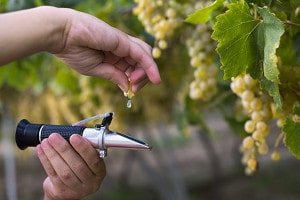About
Founded by Dr. William B. Fears, Bear Creek Vineyard was located on 40 acres in Cedar Hill, Texas. 100% family owned and operated. Dr. Fears broke the first ground in the vineyard's blackland prairie soil in 2005. Every task and aspect of the vineyard was managed and performed by family. The same hands that planted the vines in January 2006, pruned and trained them to produced award winning wines.
For Dr. Fears and the family, having to walk away from such an effort and journey was a very hard thing to do. Yet all good things must come to an end and you must walk away smiling and proud for what you were a part of; what you gave and what you received...
A heartfelt THANK YOU goes out to the few friends who helped at Bear Creek Vineyard:
- Victoria Fears for her love & support.
- Dan Gatlin of Inwood Estates for his expertise and guideance in viticulture.
- Mark Moberg, Dan's sommeliere.
- Eric Paty, Jeff Files, Ricardo Ortiz, Kevin Gentry and Turner Collie; family friends whose support and friendship helped the vineyard to grow.
- Finally Mr. Clarence Lamar, a 90 year old East Texas farmer. The epitome of Texan; kind, wise, & unbelievably hard working regardless of his age.
Operators
Family Farming
Operations Director
Logisitics Management, Accounting, Statistical Analysis, Data Visualization, Pruning Professional.
Owner / CEO
Founder, Financer, Doctor, Father, Tractor Commander.
Viticulture Director
Irrigation Specialist, Labor Management, Production Management, Farm Boy.
Terroir
Texas Blackland Prairie
Terroir is defined as:
The complete natural environment in which a particular wine is produced, including factors such as the soil, topography, and climate.
Texas Blackland Prairie is described as:
Both upland and bottomland soils are deep, dark-gray to black alkaline clays. Some soils in the western part are shallow to moderately deep over chalk. Some soils on the eastern edge are neutral to slightly acid, grayish clays and loams over mottled clay subsoils (sometimes called graylands). Blackland soils are known as “cracking clays” because of the large, deep cracks that form in dry weather.
Stats
Vineyard Statistics
Aligned East to West to maximize exposure to the Texas sun.

Planted and pruned by hand.
Vines were specifically pruned to limit grape production. Resulting in higher quality vs. higher quantity.

Brix is the sugar content of the grape juice measured as specific gravity via an optical refractometer. The higher the sugar content, the higher the alcohol content.

Planting to Full Fruit. The vines grew amazingly fast in this soil, incredibly healthy resulting in early fruit production.
Planting to Fruitful Harvest. After 5 years, the vineyard was producing high quality harvests.
Reviews
Reviews of wine made from Bear Creek Vineyard grapes
Fifty Wines That Shaped My Palate, 1984-2014 by Fredric Koeppel
"The process of learning, having our minds changed, our ideas and consciousness expanded never ends. Perhaps there will be candidates for this list from 2014, among them the Clos Saron Stone Soup Vineyard Syrah 2011, Sierra Foothills, made by Gideon Beinstock, and, oddly enough, the Inwood Estates Vineyards Chardonnay 2012, Dallas County, Texas, made by Dan Gatlin. We’ll see how I feel in another 30 years."
The New Boundary of Chardonnay Growing – Dallas County, Dec 17, 2011 by Andrew Chalk
"The historical significance of this release is obvious. This may be one of the most unique and surprising accomplishments of the wine and food community in the Dallas area ever. It is a watershed event for many reasons. As one of America’s large cities, it represents an achievement in urban wine-growing and urban farmingIt gives new meaning to the idea of “locally grown” with a type of crop never thought possible. It is a symbol of civic pride and something uniquely meaningful to our residents."
Is Dallas County the next Burgundy?, Sept 25, 2013 by Andrew Chalk
"Gatlin started the tasting with the 2012 Inwood Estate Vineyards Chardonnay, Bear Creek Vineyard, Dallas County ($39.50). You read that right. The grapes were sourced from Dallas County, grown in a small vineyard on Bear Creek Road. Gatlin ferments the wine in stainless steel. An essential technique is the use of full-cluster pressing. Under this procedure, the grape cluster cut from the vine is put into the fermentation vessel without the grapes being first stripped from the stems. The process of fermentation (conversion of sugar to alcohol and carbon dioxide) makes the grapes swell inside their skins and eventually burst. Part of the fermentation has actually occurred inside the grape skin. Gatlin prefers the technique because “it reduces the opportunity for stems to be sliced or grazed thereby releasing grassy flavors into the wine. The resulting wines are fresh and clean with fruit driven character and unobstructed florals."
Inwood Estates Vineyards, 2012 Chardonnay, ‘Bear Creek Vineyard’ Dallas County by Andrew Chalk - Oct 2, 2020
"The Chardonnay has a weighty mouthfeel, intense fruit of pineapple, guava, Meyer lemon, peach, and ripe yellow apples. The nose echoes those fruits as well as some French oak vanillin notes. There is just a hint of maderization with age on the olfactory glands from the nose so, in the event you are lucky to have some of this wine, start drinking it now."
Inwood Estates
"For the first time, Inwood Estates produced a 100% Chardonnay wine in 2010. Equally astonishing, all of the grapes in this wine were produced in Dallas County, Texas."
